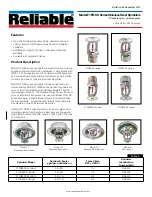
12 Special requirements for R32 units
Installation and operation manual
16
BS4~12A14AJV1B
VRV 5 branch selector unit
4P670163-1 – 2022.02
0
10
20
30
40
50
70
90
110
80
118
59
100
140
150
130
160
5 10
20
30
40
50
25
15
35
45
m [kg]
A
min
[m
2
]
No safety measure
(c)
External alarm
(d)
Ventilated enclosure
(e)
m
Total refrigerant charge in the system [kg]
A
min
Minimum room area [m²]
(a)
All other floors (=All other floors)
(b)
Lowest underground floor (=Lowest underground floor)
(c)
No safety measure (=No safety measure)
(d)
External alarm (=External alarm)
(e)
Ventilated enclosure (=Ventilated enclosure)
12.4
Safety measures
12.4.1
No safety measure
When the room area is sufficiently large, no safety measures are
required. This also includes a BS unit installed in the lowest
underground floor.
The duct connection must be replaced with the duct closing plate
accessory (see
"13.5.2 To install the duct closing plate"
BS unit test run
Before BS unit operation, it is required to perform a test run that
simulates a refrigerant leak. See
38] for
more details.
Field settings
No safety measure
Code
Description
Value
[2-0]
Cluster indication
0 (default): disable
[2-4]
Safety measures
0: disable
Note:
Some field settings need to be made on all main PCB's (A1P,
A2P and A3P) of the same BS unit. For more information, see
34].
12.4.2
External alarm
Do NOT use the external alarm safety measure in the following
cases:
▪ BS unit is installed in the lowest underground floor of a building.
▪ BS unit is installed in in an occupied space where people are
restricted in their movement.
For the external alarm safety measure, the duct connection must be
replaced with the duct closing plate accessory (see
25]).
An external alarm circuit (field supply) must be connected to the SVS
output of the BS unit, see
This alarm system must warn audibly AND visibly (e.g. a loud buzzer
AND a flashing light). The audible alarm must be 15 dBA above the
background sound level at all times.
At least one alarm must be installed in the occupied space in which
the BS unit is installed.
For the occupancy listed below, the alarm system must
additionally
warn at a supervised location with 24-hour monitoring:
▪ with sleeping facilities.
▪ where an uncontrolled number of people are present.
▪ accessible for persons not familiar with the necessary safety
precautions.
To warn at a supervised location, connect a supervisor remote
controller to the system. This supervisor remote controller can be
connected to any indoor unit of the system, and will warn at the
supervised location in case a refrigerant leak is detected in any BS
unit of the system.
Note:
An address number for the supervisor
remote controller must be assigned to the BS unit. See
When the R32 sensor in the BS unit detects a refrigerant leak, the
SVS output will close and activates the alarm. An error message will
display on the remote controllers of the connected indoor units. See
41].
BS unit test run
Before BS unit operation, it is required to perform a test run that
simulates a refrigerant leak. See
38] for
more details.
Field settings
External alarm
Code
Description
Value
[2-0]
Cluster indication
0 (default): disable
[2-4]
Safety measures
1 (default): enable
[2-7]
Ventilated enclosure
0: disable
Note:
Some field settings need to be made on all main PCB's (A1P,
A2P and A3P) of the same BS unit. For more information, see
12.4.3
Ventilated enclosure
A ventilated enclosure is required as a safety measure in case the
other safety measures (see
16] and
16]) are not allowed.
For the ventilated enclosure safety measure, ductwork and an
extraction fan are installed. See
"13.5 Installing the ventilation
24] for ductwork (field supply) installation and
34] to connect the extraction fan
circuit (field supply) to the BS unit.
Note:
As an additional safety measure, an external alarm circuit
(field supply) can be installed using the SVS output. See
When the R32 sensor in the BS unit detects a refrigerant leak, it will
activate the safety measures. This includes opening the damper of
the unit to allow air to enter and evacuate the refrigerant leak,
activate the fan output signal to trigger an extraction fan to operate,
and display an error message on the remote controllers of the
connected indoor units.
A damper at the air inlet of the BS unit enables a choice between 3
types of configurations (see below). The damper opens when a
refrigerant leak has been detected in the BS unit. This creates an
airflow path from the leaking BS unit to the extraction fan.
a
a
Damper
















































